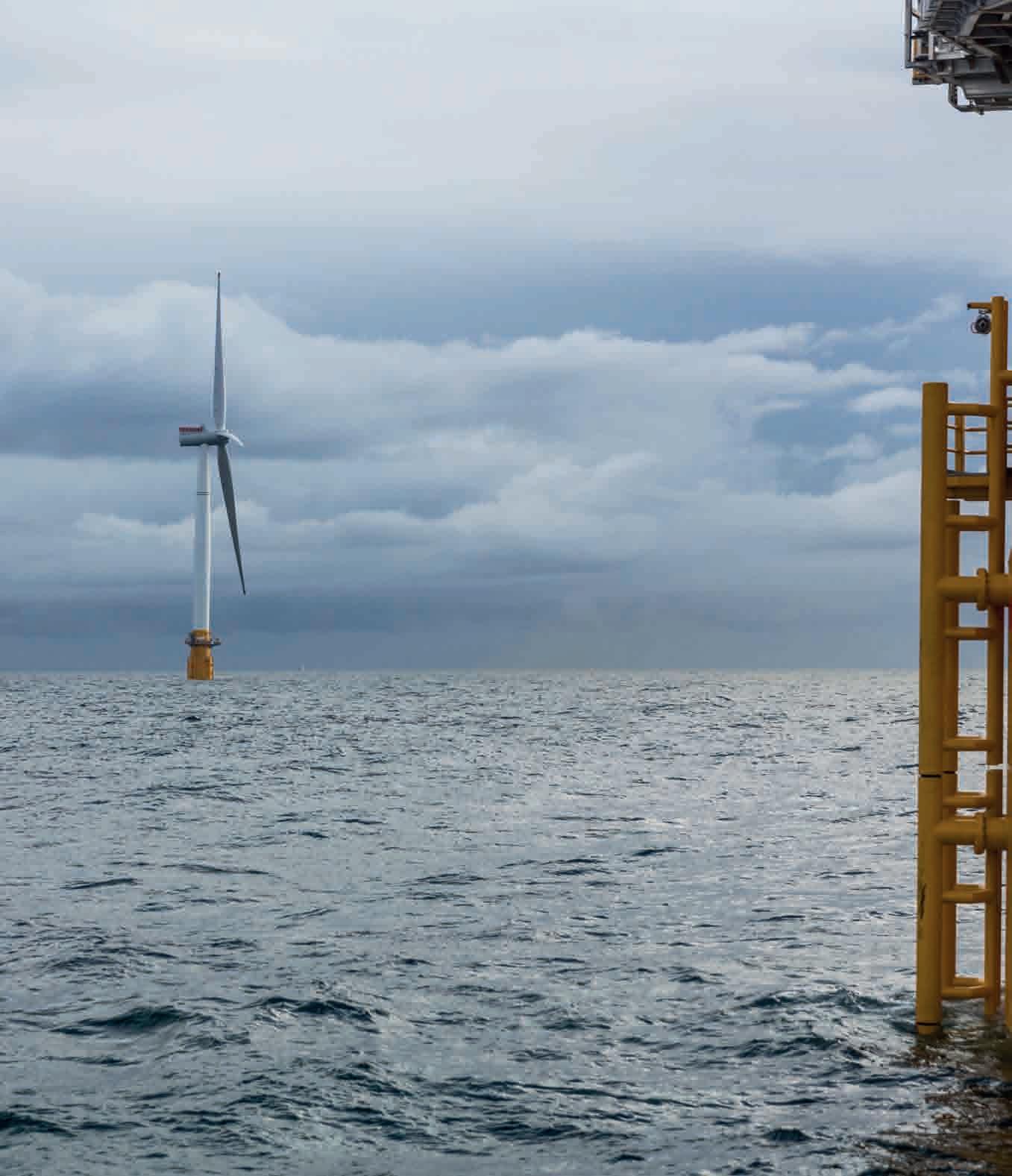
6 minute read
Eight winners
FLOATING WIND TECHNOLOGY ACCELERATION COMPETITION
THE FLOATING WIND TECHNOLOGY ACCELERATION COMPETITION RUN BY THE CARBON TRUST’S FLOATING WIND JOINT INDUSTRY PROJECT HAS ANNOUNCED EIGHT TECHNOLOGIES TO RECEIVE SCOTTISH GOVERNMENT FUNDING AND DEVELOPER SUPPORT.

Photo courtesy of Carbon Trust.

Photo courtesy of the Scottish Government.
Paul Wheelhouse, Minister for Energy, Scotland, “Given Scotland’s unique deep water profile, floating offshore wind will undoubtedly play a huge role in our future energy system.” Jan Matthiesen, Director Offshore Wind at the Carbon Trust says, “Floating wind is on the precipice of scaling to deliver significant capacity in the energy system.”
Hywind Scotland floating offshore windfarm. Floating offshore wind is forecast to scale up to 12GW of capacity globally by 2030.
A3D printed anchor and a self-charging mooring line monitoring device are two of eight innovative technologies announced recently as winners of a technology acceleration competition, funded by the Scottish Government and run by the Carbon Trust’s Floating Wind Joint Industry Project (Floating Wind JIP). The competition was designed to address four key industry challenge areas, that need to be overcome to commercialise floating wind. The four areas were identified in Phase 1 of the Floating Wind JIP: monitoring and inspection, mooring systems, heavy lift maintenance and tow to port maintenance. The eight technologies will receive a share of EUR 1.1 million from the Scottish Government, in addition to support from the fourteen leading offshore wind developers represented in the Floating Wind JIP.
Emerging sector Floating offshore wind is an emerging renewables sector, with significance for places like Scotland where water depths often do not allow for the use of fixed bottom turbines. Floating wind is forecast to scale up to 12GW of capacity globally by 2030, becoming a market estimated to be worth EUR 35 billion. In Scotland, the draft Sectoral Marine Plan for Offshore Wind Energy, outlines the Scottish Government’s plans to deliver up to 10GW of offshore wind, the majority of which will be in deeper waters suitable for floating wind. To achieve this scale, accelerating technology innovation to lower the levelised cost of energy from floating wind will be critical. Paul Wheelhouse, Minister for Energy, Scotland comments, “We are funding the Carbon Trust’s Floating Wind Technology Acceleration Competition in order to address key technical challenges in the sector. Given Scotland’s unique deep water profile, floating offshore wind will undoubtedly play a huge role in our future energy system, as we transition to a net zero economy and we know that key overseas markets are also looking to exploit floating wind technology to meet their own energy needs. The innovative solutions developed by the competition winners will help reduce costs in the sector and could allow floating wind technology to reach commercial scale deployment earlier than previously anticipated and that could prove vital as Scotland and other coastal nations seek to head off the climate emergency.” Jan Matthiesen, Director Offshore Wind at the Carbon Trust says, “Floating wind is on the precipice of scaling to deliver significant capacity in the energy system. The competition is supporting a number of exciting technology innovations in critical challenge areas identified by industry. We are excited and optimistic for both the potential of these innovations to reach commercialisation and their ability to positively impact the sector.”
Floating Wind JIP The Floating Wind JIP, formed in 2016, is a collaborative research and development initiative between the Carbon Trust, Scottish Government, and fourteen leading international offshore wind developers: EnBW, ENGIE, Eolfi, Equinor, innogy, Kyuden Mirai Energy, Ørsted, RWE, ScottishPower Renewables, Shell, SSE, TEPCO, Vattenfall, and Wpd. It has been established to accelerate the development of floating wind technology through cost reduction and derisking of technology components and their manufacture, operation and maintenance.
The winning technologies The successful applicants are from a variety of sectors including oil & gas, IT & telecommunications, and engineering. The innovations range in maturity, therefore the funding will be used to support different activities from desktop studies to offshore demonstration.
The companies and their winning technologies are:
Monitoring and inspection – Fugro, AS Mosley, and University of
Strathclyde – Condition monitoring software which uses readily available acceleration and motion data points from floating offshore wind structures to extrapolate how the wider structure responds to stress. >>
smm-hamburg.com /trailer the leading international maritime trade fair
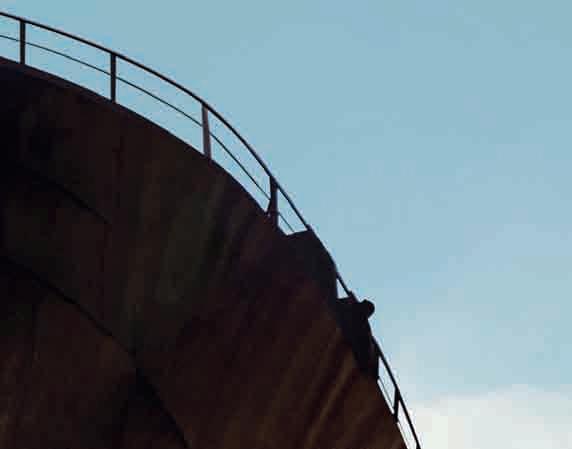

buy eTicket and save up to 25% or redeem invitation smm-hamburg.com/ticket eTicket = easy access
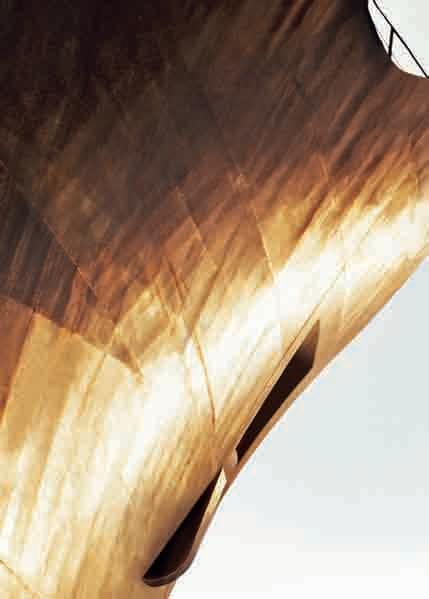



driving the maritime transition 8 –11 sept 2020 hamburg




SMM fuels change in the maritime industry by bringing together its most influential players and presenting solutions that make shipping greener, smarter and safer. Be part of it and see what’s technologically possible, connect with peers and get fresh impetus for your business:
• 2,200+ exhibitors from the entire maritime value chain • 50,000 industry professionals from 120+ countries • Top-notch conferences and first-class networking events
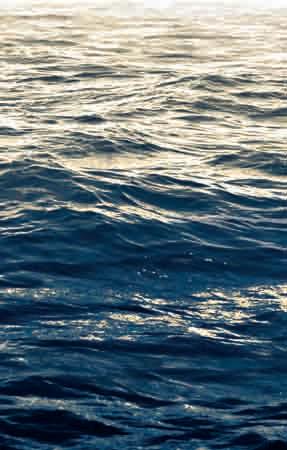
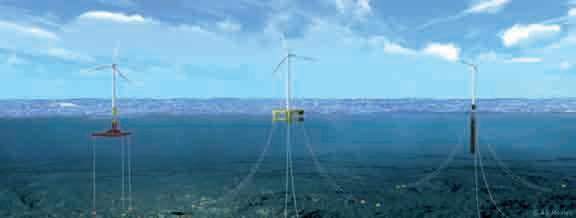
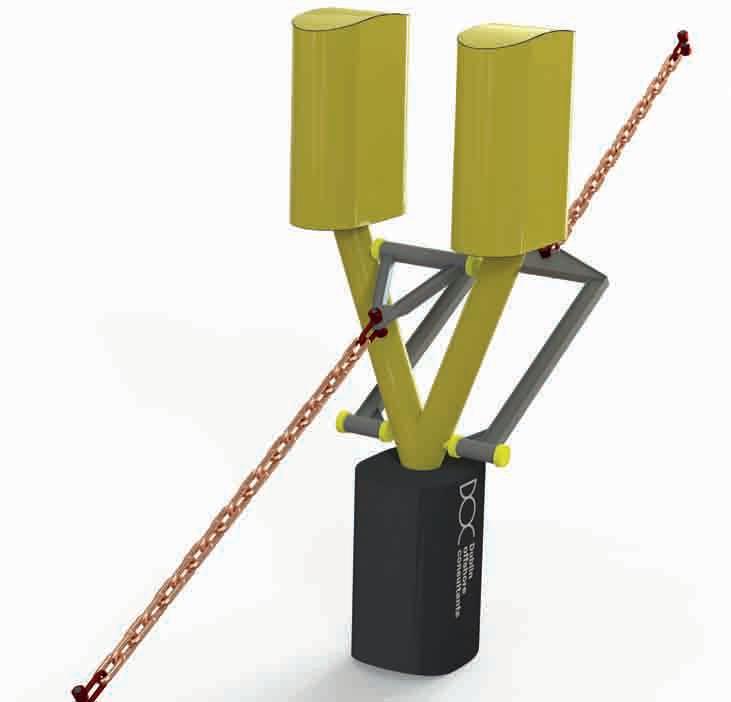
AS Mosley, along with consortium partners, Fugro and Strathclyde University, has been awarded funding from The Carbon Trust, to develop new technology for monitoring Floating Offshore Wind Turbines (FOWT).
Image courtesy of Dublin Offshore.
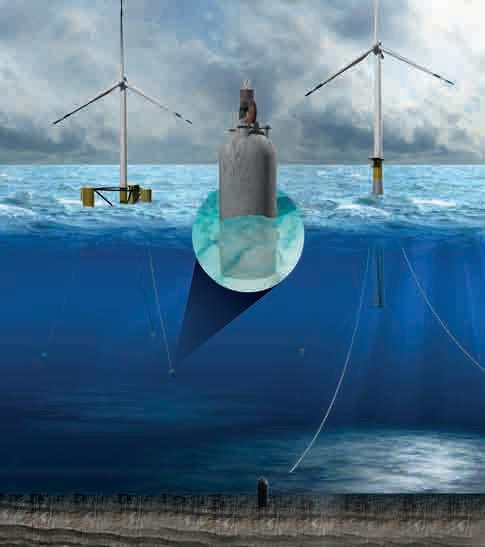
Dublin Offshore’s load reduction device, sits partway up the mooring line and pivots in the water to minimise movement of the floating platform during wave events.
RCAM Technologies and the Floating Wind Technology Company designed a concrete anchor, that will be produced using 3D printing technology, and which is sunk and then embedded in the seabed through suction.
Image courtesy of RCAM/FWTC
– Technology from Ideas and WFS – A load monitoring system to identify stresses on mooring lines and times when maintenance is needed. The monitoring system will be integrated into an existing spring, which also acts as a dampener on mooring lines, and is powered by movement of the lines.
Mooring systems – Dublin Offshore – A load reduction device that sits partway up the mooring line and pivots in the water to minimise movement of the floating platform during wave events.
– Intelligent Mooring Systems and University of Exeter – A new pressurebased dampener which sits between the platform and mooring line to reduce the load on floating platforms.
– RCAM Technologies and the Floating Wind Technology Company – A concrete anchor, produced using 3D printing technology, which is sunk and then embedded in the seabed through suction.
– Vryhof – An adjustable lock on the seabed used to manipulate the tension of the mooring lines. This is an alternative to a winch sitting on the turbine platform, and enables vessels to adjust the tension of mooring lines at a safe distance from the platform.
Heavy lift maintenance – Conbit – A temporary crane which sits on top of the turbine (the nacelle) to winch parts up and down for maintenance. This could enable larger turbines to be serviced offshore than is currently feasible.
Tow to port maintenance – Aker Solutions – A splice box connecting two dynamic array cables, and allowing them to be wet-stored on the seabed when a turbine is towed to port. This will also enable an array of floating wind turbines to remain operational when one floating platform is removed for maintenance.
i. carbontrust.com










